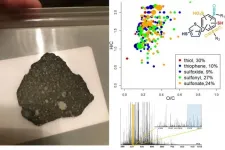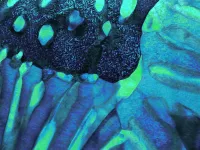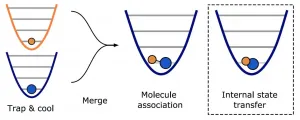Development of source technology for the use of wearable devices without recharging
A sponge-type scaffold has been developed through a process involving melting sugar; as it also overcomes performance loss issues, this technology is expected to increase potential for producing high-efficiency flexible thermoelectric devices
2021-04-05
(Press-News.org) Despite the continued development and commercialization of various wearable electronic devices, such as smart bands, progress with these devices has been curbed by one major limitation, as they regularly need to be recharged. However, a new technology developed by a South Korean research team has become a hot topic, as it shows significant potential to overcome this limitation for wearable electronic devices.
The Korea Institute of Science and Technology (KIST), or KIST, announced that a research team led by Director Jin-Sang Kim of the Jeonbuk Institute of Advanced Composite Materials has developed a high-efficiency flexible thermoelectric device that is capable of autonomously generating some of the electricity required for its operation from body heat. The device developed by the team features enhanced thermal insulation capabilities, made possible through the fabrication of the flexible silicone compound (PDMS) into a sponge-like configuration, which was then used as a framework for innovatively enhancing the device's performance.
Thermoelectric devices are able to generate electricity by utilizing the difference in temperature between the two ends of the device, and have been used as eco-friendly generators of power from sources such as vehicle engine heat or waste heat from power plants. Conversely, by instead applying electricity to the thermoelectric device, one end of the device can be cooled while the other generates heat, enabling them to also be used in temperature control systems for small refrigerators, vehicle cooling sheets, and semiconductor equipment.
Normal thermoelectric devices commonly have a rigid ceramic substrate supporting the thermoelectric semiconductor, making them difficult to use on curved surfaces, whereas in flexible thermoelectric devices, a polymer material encapsulates the thermoelectric semiconductor, as opposed to a ceramic substrate, allowing the device to be bent easily. When such a device is worn on the body, electricity can be autonomously generated, and it can also potentially be used as a portable air conditioner. As a result, flexible thermoelectric devices have been garnering much attention in the field of wearable electronic devices. However, the polymer materials used to produce the flexible substrate have a high thermal conductivity, and therefore cannot block heat at both ends of the device. Consequently, the flexible devices that have been produced so far have had the fatal shortcoming of not being able to perform at a level comparable to commercial thermoelectric devices with a rigid substrate.
In pursuing a solution to this issue, the research team at KIST fabricated a sponge-configuration polymer material, by first pouring a silicone compound solution onto a sugar cube and allowing the solution to solidify, and then dissolving the sugar cube in water. Consequently, as the sugar cube dissolved, the space which had been occupied by the cube was transformed into a structure consisting of micro air bubbles. The thermal insulation capability of this structure was 50% higher than conventional materials, enabling it to effectively block the transfer of heat. The team at KIST used this substrate as a support frame to develop a flexible thermoelectric device that suffers from no loss of performance. The team's device demonstrated performance that was superior to existing flexible thermoelectric devices by more than 20%, and comparable to existing commercial devices. The research team (including the first co-authors: Dr. Sung-Jin Jung, Dr. Joonchul Shin) was able to successfully use their flexible device to turn on an LED light with body heat.
Director Jin-Sang Kim of the Jeonbuk branch of KIST stated that "the efficiency of our flexible thermoelectric device was raised to a level comparable to that of commercial thermoelectric devices through a simple, inexpensive process that requires pouring a solution on sugar and allowing the solution to solidify." He also commented, "if we used a sufficient number of thermoelectric devices, it should certainly be possible to produce smart bands that operate on body heat alone."
INFORMATION:
This research project was conducted as part of the National Research Council of Science & Technology's Creative Allied Project, as well as the Creative Materials Discovery Program headed by the National Research Foundation of Korea and supported by the Ministry of Science and ICT (MSIT). The findings of this study were published in the March edition of the international journal "Nano Energy."
[Attachments] See images for this press release:

ELSE PRESS RELEASES FROM THIS DATE:
2021-04-05
A new study at Tel Aviv University reveals a possible defense mechanism developed by fireflies for protection against bats that might prey on them. According to the study, fireflies produce strong ultrasonic sounds - soundwaves that the human ear, and more importantly the fireflies themselves, cannot detect. The researchers hypothesize that these sounds are meant for the ears of bats, keeping them away from the poisonous fireflies, and thereby serving as a kind of 'musical armor'. The study was led by Prof. Yossi Yovel, Head of the Sagol School of Neuroscience, and a member of the School of Mechanical Engineering and the School of Zoology at the George S. Wise Faculty of Life Sciences. It was conducted in collaboration with the Vietnam Academy of Science and Technology (VAST). ...
2021-04-05
Could the next Hollywood blockbuster be written by a computer? Scientists from the University of Granada (UGR) and the University of Cádiz (UCA) have designed the world's first computer system based on artificial intelligence techniques that can help film scriptwriters create storylines with the best chance of box-office success.
The researchers focused their analysis on the "tropes" of existing films--that is, the commonplace, predictable, and even necessary clichés that repeatedly feature in film plots, based on rhetorical figures. These storytelling devices and conventions enable directors to readily convey scenarios that ...
2021-04-05
A lot of people think regret must be a good thing because it helps you not repeat a mistake, right?
But that turns out not to be the case. Not even when it comes to casual sex, according to new research from the Norwegian University of Science and Technology's (NTNU) Department of Psychology.
"For the most part, people continue with the same sexual behaviour and the same level of regret," says Professor Leif Edward Ottesen Kennair.
So, we repeat what we thought was a mistake, and we regret it just as much the next time around.
Professor Kennair and colleagues professor Mons Bendixen and postdoctoral ...
2021-04-05
Scientists from Russia and Germany studied the molecular composition of carbonaceous chondrites - the insoluble organic matter of the Murchison and Allende meteorites - in an attempt to identify their origin. Ultra-high resolution mass spectrometry revealed a wide diversity of chemical compositions and unexpected similarities between meteorites from different groups. The research was published in the Scientific Reports.
Carbonaceous chondrites contain nearly the entire spectrum of organic molecules encountered on Earth, including nucleic acids which might have played a pivotal role in the origin of life. Since the majority of modern meteorites are of nearly the same age ...
2021-04-05
WHO Ingrid Katz, MD, MHS, Associate Physician, Department of Medicine, Brigham and Women's Hospital; lead author of a new Perspective piece published in the New England Journal of Medicine.
WHAT While the U.S. has begun to vaccinate millions of Americans each day, COVID-19 vaccine supplies around the world remain scarce. Experts estimate that 80 percent of people in low-resource countries will not receive a vaccine in 2021. At the time of the paper's writing, the global vaccination rate was 6.7 million doses per day -- a rate at which it would take 4.6 years to achieve global herd immunity. In a new Perspective piece in the New England Journal of Medicine, Katz and colleagues highlight the need ...
2021-04-05
A recent study of more than 2,000 companies finds that corporations feeling the pinch of financial constraints can benefit significantly from taking a more aggressive stance in their tax planning strategies. One takeaway of the finding is that tax authorities should look closely at the activities of companies facing financial constraints to make sure their tax activities don't become too aggressive.
Financial constraints aren't unusual and occur when a company can't afford to fund a project that would increase its value. Sometimes the constraints are caused by an external event - like a pandemic - that leaves companies with less income than they were anticipating. ...
2021-04-05
Manufacturing - Mighty Mo
Oak Ridge National Laboratory scientists proved molybdenum titanium carbide, a refractory metal alloy that can withstand extreme temperature environments, can also be crack free and dense when produced with electron beam powder bed fusion. Their finding indicates the material's viability in additive manufacturing.
Molybdenum, or Mo, as well as associated alloys, are difficult to process through traditional manufacturing because of their high melting temperature, reactivity with oxygen and brittleness.
To address these shortcomings, the team formed a Mo metal matrix composite by mixing molybdenum and titanium carbide powders and used an electron beam to melt the ...
2021-04-05
Piping plover breeding groups in the Northern Great Plains are notably connected through movements between habitats and show lower reproductive rates than previously thought, END ...
2021-04-05
A comprehensive assessment of 12 different strategies for reducing beef production emissions worldwide found that industry can reduce greenhouse gas (GHG) emissions by as much as 50% in certain regions, with the most potential in the United States and Brazil. The study, " END ...
2021-04-05
In 2018, Kang-Kuen Ni and her lab earned the cover of Science with an impressive feat: They took two individual atoms, a sodium and a cesium, and forged them into a single dipolar molecule, sodium cesium.
Sodium and cesium normally ignore each other in the wild; but in the Ni lab's carefully calibrated vacuum chamber, she and her team captured each atom using lasers and then forced them to react, a capability that gifted scientists with a new method to study one of the most basic and ubiquitous processes on Earth: the formation of a chemical bond. With Ni's invention, scientists could not only discover more about our chemical underpinnings, they could start creating ...
LAST 30 PRESS RELEASES:
[Press-News.org] Development of source technology for the use of wearable devices without recharging
A sponge-type scaffold has been developed through a process involving melting sugar; as it also overcomes performance loss issues, this technology is expected to increase potential for producing high-efficiency flexible thermoelectric devices







